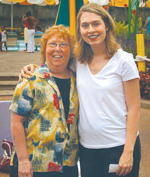|
by Dawn
Brazell
Public Relations
As a transplant physician,
Michelle Hudspeth, M.D., often
tears up when she sees firsthand
the raw emotion on transplant day
as parents watch the bag of bone
marrow be delivered and
administered to their child.
"That bag offers hope. The
look in their eyes says it all.
For the child and the family, that
bag means everything. It means
their child has a chance. It is
rare that I don't have tears in my
eyes during the infusion."
Thousands of patients with blood
cancers like leukemia and
lymphoma, sickle cell and other
life-threatening diseases need a
bone marrow transplant. The Be The
Match Registry provides access to
10 million potential donors and
nearly 165,000 cord blood units.
According to the program, nearly
half of all patients in the U.S.
in 2011 received the unrelated
transplant they needed. Most
patients, about 70 percent, do not
have a matching donor in their
family.
Hudspeth, director of the division
of Pediatric Hematology/Oncology,
recalls joining the registry as a
first-year pediatric oncology
fellow at Johns Hopkins
Hospital. The hospital was
having a bone marrow donor drive,
and she knew she wanted to be a
bone marrow transplant physician.
 Dr. Michelle
Hudspeth, right, gives her
marrow recipient, Kathy Voigt, a
hug. Dr. Michelle
Hudspeth, right, gives her
marrow recipient, Kathy Voigt, a
hug.
"I was pregnant at the time and I
almost put off joining that day,
knowing that you can't donate
while pregnant. But I
stopped, in between a million
pages and doing procedures, to
join."
She's so grateful she did.
Several months later on maternity
leave with her daughter, she was
called. It turns out that she was
the only match in the registry for
her recipient with them sharing a
rare HLA-C allele. Most people on
the donor list never get called
given the chances of being a match
are one in 524. Hudspeth underwent
more testing and in April 2004 had
a bone marrow harvest, choosing a
spinal block for anesthesia
instead of using general
anesthesia since she still was
nursing her daughter.
Of the two types of donations, a
peripheral blood stem cell
procedure or the more extensive
bone marrow harvest, Hudspeth had
to undergo the latter but said she
didn't feel a thing during the
procedure. Needles were placed
into her back hip bones multiple
times to withdraw bone marrow. She
donated close to two liters of
bone marrow and opted at her
request to receive back a
transfusion of her own unit of
blood afterwards. She went home
that same day. She said she
was sore for several days, but was
able to return to work on Monday.
"I would encourage absolutely
everyone to join the registry, and
of course doctors. We joined
this profession to help and heal
others. In a world of health care
that is often tainted by red tape
and insurance issues, this offers
the chance to truly and simply
help another person."
Hudspeth said she enjoyed getting
to meet her recipient, Kathy
Voigt, a 56-year-old wife and
mother of three children. (Donors
have the choice of meeting their
recipients after a year following
the procedure.) Voigt had relapsed
acute myelogenous leukemia and the
transplant meant that she was able
to see her youngest son graduate
from high school. Hudspeth got to
meet her in 2006 and was surprised
to find that they live only about
two hours away from each other.
"My daughter was obsessed with
Elmo and Sesame Street at the
time. Her oldest daughter
was working as Elmo at Sesame
Place during the summer break from
college. We met at Sesame
Place and my daughter got her own
special meet and greet with Elmo.
As a mother myself, knowing that I
was able to give another mother
the chance to be there for her
children means more than I can
really put into words. I
would donate again in a
heartbeat."
As a transplant physician,
Hudspeth performs bone marrow
harvests for donors for the
National Marrow Donor Program as
well as bone marrow harvests for
children who are donating for
their brother or sister. She
likes to be able to tell them that
she has been through the very same
procedure.
"In particular, I think, and this
is my hope, that it is somewhat
comforting to the kids that the
person doing the procedure has
actually undergone the very same
procedure. I think it is
vitally important that our donors
receive exceptional care."
Whenever she can, she encourages
others to register.
"When you have seen children die
because they have no available
donor, you will do anything in
your power to prevent that from
happening to anyone."
|



 Dr. Michelle
Hudspeth, right, gives her
marrow recipient, Kathy Voigt, a
hug.
Dr. Michelle
Hudspeth, right, gives her
marrow recipient, Kathy Voigt, a
hug.